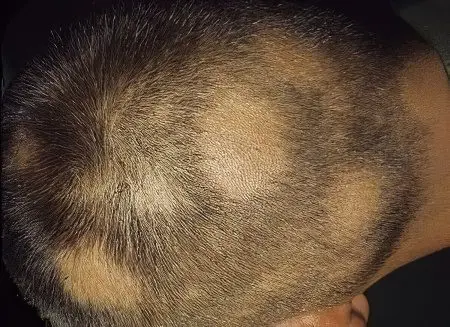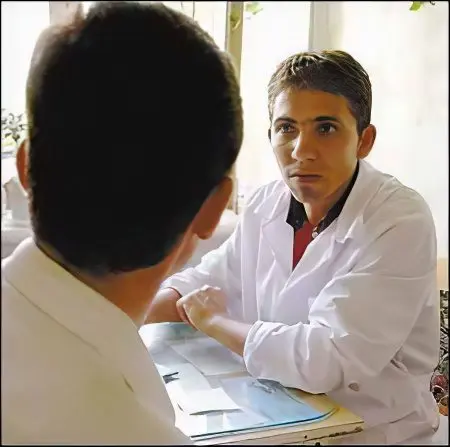Alopecia areata mostly occurs in young people under the age of 25, and the disease affects men and women equally often. There are several forms of pathology: diffuse, local, subtotal, ophiasis, total and universal.
The causes of alopecia areata remain to date not fully understood. It is assumed that the pathological process is triggered by a local autoimmune mechanism, as a result of which damage to the hair follicle occurs and the immune susceptibility of the cells involved in the formation of the follicle is disturbed, and there is no specific reception of the papillae of the hair follicles.
There is also a strong association between alopecia areata and certain HLA class II alleles, which most likely become markers and play a major role in the development of predisposition to the development of alopecia areata. Moreover, the frequency of occurrence of two more alleles – DRB1 * 0401 and DQB1 * 0301 – is significantly higher among patients who have total or universal alopecia, which is considered the extreme manifestations of the pathological process.
Over time, with a protracted disease and an increase in its severity, an imbalance in a number of indicators of cellular immunity becomes apparent. There is a decrease in the level of opiate hormones, in particular neurotensin, endorphin, leu-enkephalin.
Hair follicles become smaller, and activated T-lymphocytes of CD4 and CD8 clones, as well as Langerhans cells, which are located in the border area between the hair matrix and the papilla, as well as in peribulbar infiltrates, are involved in the pathological process.
In the initial stage of the disease, the lumen of the vessels that feed the hair follicle expands, and later their obliteration occurs. Alopecia areata are formed as a result of a violation of the cycle of normal hair growth from the bulb matrix. Hair prematurely enters the phase preceding the loss – the telogen phase. If the hair growth cycle is disturbed during the anagen phase, the hair shaft breaks and a dystrophic end of the hair is formed at its proximal end at the site of the break.
Symptoms of alopecia areata

The diffuse form of alopecia areata is accompanied by a pronounced process of hair loss on the surface of the skin of the head.
The local form of the pathological process is characterized by the appearance of separate foci with clear boundaries and a rounded shape.
The subtotal form is accompanied by a loss of more than 40% of the hair.
With ophiasis, the foci of the pathological process affect the entire marginal zone on which hair growth occurs, in some cases only the occipital region or only the forehead and temples.
The total form of alopecia areata causes complete hair loss on the scalp.
The universal form of alopecia leads to hair loss both on the scalp and on the eyebrows, eyelashes, human body, along with the complete loss of vellus hair. The course of this disease is unpredictable. The process of overgrowing of old foci of baldness can be accompanied by the appearance of new ones, and the disease itself lasts for several decades. Alopecia areata, which proceeds according to the universal type, can manifest itself in the form of separate episodes or recur after some time. Repeated cases of the disease can take a mild form or proceed according to the type of subtotal, total or universal alopecia. Severe forms of alopecia areata can occur at the very beginning of the pathology. In addition, each form of the disease can pass one into another.
There are several stages of alopecia areata.
In the case of the active (progressive) stage, the skin in the foci of baldness turns red, swells a little, the patient notes a burning sensation and a tingling sensation along the edge of the pathological focus. On examination, you can see broken hair, resembling an exclamation point, and a “loose hair” area in which the hair can be easily pulled out with little effort. The boundary of such a zone is usually from 0,5 to 1 cm. If we examine the hair shaft taken from the pathological focus under a microscope, one can notice dystrophic ends resembling a broken rope at the proximal end of the hair.
The stationary stage is characterized by the absence of a “loose hair” zone on the border of the pathological focus and pale skin in the area of the focus.
At the next stage – the stage of regression – in the focus of alopecia, you can notice the growth of vellus hair, devoid of pigment, and partial growth of terminal hair, with pigmentation.
The nail plates during the disease may have characteristic dystrophic changes: indentations resembling a thimble, the nails may be longitudinally striated, their free edge may have a wavy pattern. A mild (local) form of alopecia is accompanied by similar changes in 20% of cases, in patients suffering from a total or universal form of nested alopecia, similar symptoms occur in 94% of cases.
Treatment of alopecia areata

Treatment of alopecia areata is carried out by introducing glucocorticosteroids into pathological foci, the meaning of this therapy lies in the immunosuppressive effect of drugs. If the area of the lesion is more than 50% of the scalp, on which hair growth occurs, then treatment with corticosteroids does not have the desired effect.
To date, local treatment with preparations containing corticosteroids has been recognized as ineffective even in combination with carriers that promote deeper penetration of hormonal preparations.
Topical immunosuppressive therapy of alopecia areata can be carried out using dinitrochlorobenzene, dibutyl ester of squaric acid and diphenylcyclopropenone.
Properly selected systemic use of steroids can reverse rapidly progressive alopecia areata.
It is possible to suppress active clones of lymphocytes with immunotropic drugs.
In some cases, photochemotherapy is effective, as well as some adjuvant methods of influencing lesions.
When choosing methods for treating alopecia areata, the peculiarities of the constitution of patients, background diseases are taken into account.
The use of biogenic stimulants allows you to accelerate the process of tissue repair. To correct some blood parameters, preparations containing leech saliva extract may be recommended. In some forms of alopecia areata, zinc preparations may be indicated.
External means of concomitant therapy include a wide range of irritants (turpentine ointment, efkamon), stimulators of creatinocyte proliferation processes, drugs that improve tissue nutrition, and also improve tissue microcirculation. Outwardly, medicines containing silicon can also be used, which can improve the structure of the hair, or drugs whose therapeutic effect is due to exposure to the affected areas of the skin of extracts from the placenta.
Here is a list of the most popular treatments:
The best shampoo for hair restoration and growth
Medical treatment of alopecia (full list of drugs)
Minoxidil for hair loss
Finasteride for hair loss
Hair transplant: answers to basic questions
In practice, in the treatment of alopecia areata, preparations from naftalan alcohol, tincture of hot pepper, Spanish flies, and chilibukha are widely used. Their effectiveness in some cases can be explained by a small stimulating effect, but in most cases there is a placebo effect.
Patients may be recommended massage or cryomassage of the scalp, applications with paraffin (ozocerite), a ten-day course of treatment with d’Arsonval currents, diathermy of sympathetic nodes in the cervical vertebrae, ozone therapy of the scalp.
Of the methods of physical and pharmaceutical effects, electrophoresis with a solution of reserpine, aminophylline, etc. is most often used.
In a number of cases, the physico-biological effect based on the reflexotherapeutic effect is effective. Classical acupuncture, electropuncture, as well as exposure to certain types of electromagnetic radiation, the use of a laser, ultraviolet, and microwaves have received the greatest popularity in the treatment of alopecia areata from the whole variety of techniques today.
Author of the article: Herman Olga Leonidovna, trichologist, specially for the site ayzdorov.ru









